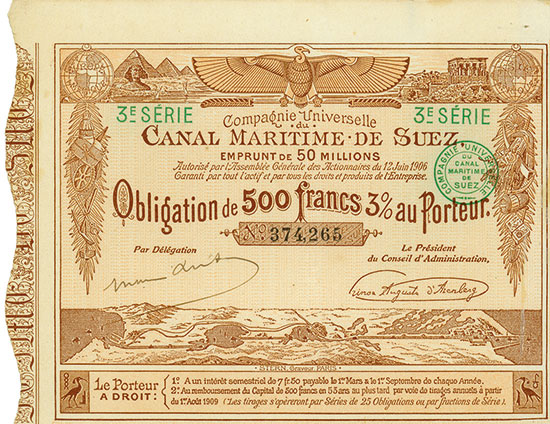By: HWPH Historisches Wertpapierhaus AG
lot # 292 - deutschland germany
Rhine-Main-Danube Corporation (Rhein-Main-Donau AG); New York, 01.09.1925, 7 % Sinking Fund Gold Debenture Series A über US-$ 500, #D310, 38,2 x 25,2 cm, grün, schwarz, weiß, Knickfalten quer, entwertet. Bereits 793 versuchte Karl der Große die Donau und den Rhein zu verbinden. Im 19. Jahrhundert ließ König Ludwig I. von Bayern einen 173 Kilometer langen Kanal von Kehlheim bis Bamberg bauen - den Ludwig-Main-Donau-Kanal. 100 Schleusenanlagen und eine geringe Breite machten ihn jedoch nur schlecht befahrbar. 1921 erfolgte dann die Gründung der Rhein-Main-Donau AG. Ihr Ziel war der Neubau des Kanals. Am 25.09.1992 wurde schließlich die 171 Kilometer lange Strecke von Kehlheim nach Bamberg eröffnet. Damit war eine 3.500 Kilometer lange Wasserstraße zwischen der Nordsee und dem Schwarzen Meer geschaffen. Hauptaktionäre der Gesellschaft sind der Freistaat Bayern und die Bundesrepublik Deutschland. The Ludwig Canal, also known as Ludwig-Donau-Main-Kanal or Ludwigskanal, was built between 1836 and 1846. It connected the Danube River at Kelheim with the Main River at Bamberg. The canal was 172.4 kilometres long. It was connecting the Danube basin at the Black Sea with the Rhine basin in Rotterdam. This example of architecture got its status because of the crossing of the European Watershed. By means of 100 locks the canal manages a height difference of 260 meters. The idea of a navigable connection between the Rhine respective the Main and the Danube was already born in Frankish Empire. Charlemagne already built the Fossa Carolina in 793. It connected the Altmühl with the Swabian Rezat and is located next to Treuchtlingen. The project was abandoned within a short time. Several suggestions and concepts were published in the following 1,000 years. King Louis I of Bavaria engaged the royal architect Heinrich Freiherr von Pechmann in 1825 to develop a plan for the canal. The plan was published in 1832. Louis I established a law regarding the building of a canal between the Danube and the Main in 1834. A joint stock company was founded in 1835. The company financed the project. The State of Bavaria owned 25 per cent of the shares. The shares were placed by the Rothschild Bank. There was a treaty with the Rothschild Bank that promised an interest of 4 per cent per year, if the canal was not finished before 1 July 1842. The work at the canal started on 1 July 1836. Several problems occurred in the meantime. Architect Pechmann was pensioned off in 1843. Especially the linking canal at Schwarzach caused problems. The first part of the canal between Bamberg and Nuremberg was opened by King Louis I on 6 May 1843. The complete canal was finally transferred to the joint stock company on 15 July 1846. Instead of eight million Gulden the canal caused costs of 17.5 million Gulden. There were attempts to improve the navigability of the canal at the end of the 19th century. Therefore the Rhein-Main-Donau-AG was founded in 1921. The shares were almost completely held by the German Reich (ca. 62 per cent) and the Free State of Bavaria (ca. 36 per cent). There were plans of closing down the canal and use the river bed as autobahn during the Second World War. The war damage was repaired quickly, but nevertheless the canal was closed down in 1950. The successor of the canal is the much larger Rhine–Main–Danube Canal which was built between 1960 and 1992. The canal is also known as Europa Canal. Between Beilngries and Nuremberg the Ludwig Canal is still preserved in his historical extent.
VF
HWPH Historisches Wertpapierhaus AG
Send Email to HWPH Historisches Wertpapierhaus AG Or Visit WebSite












